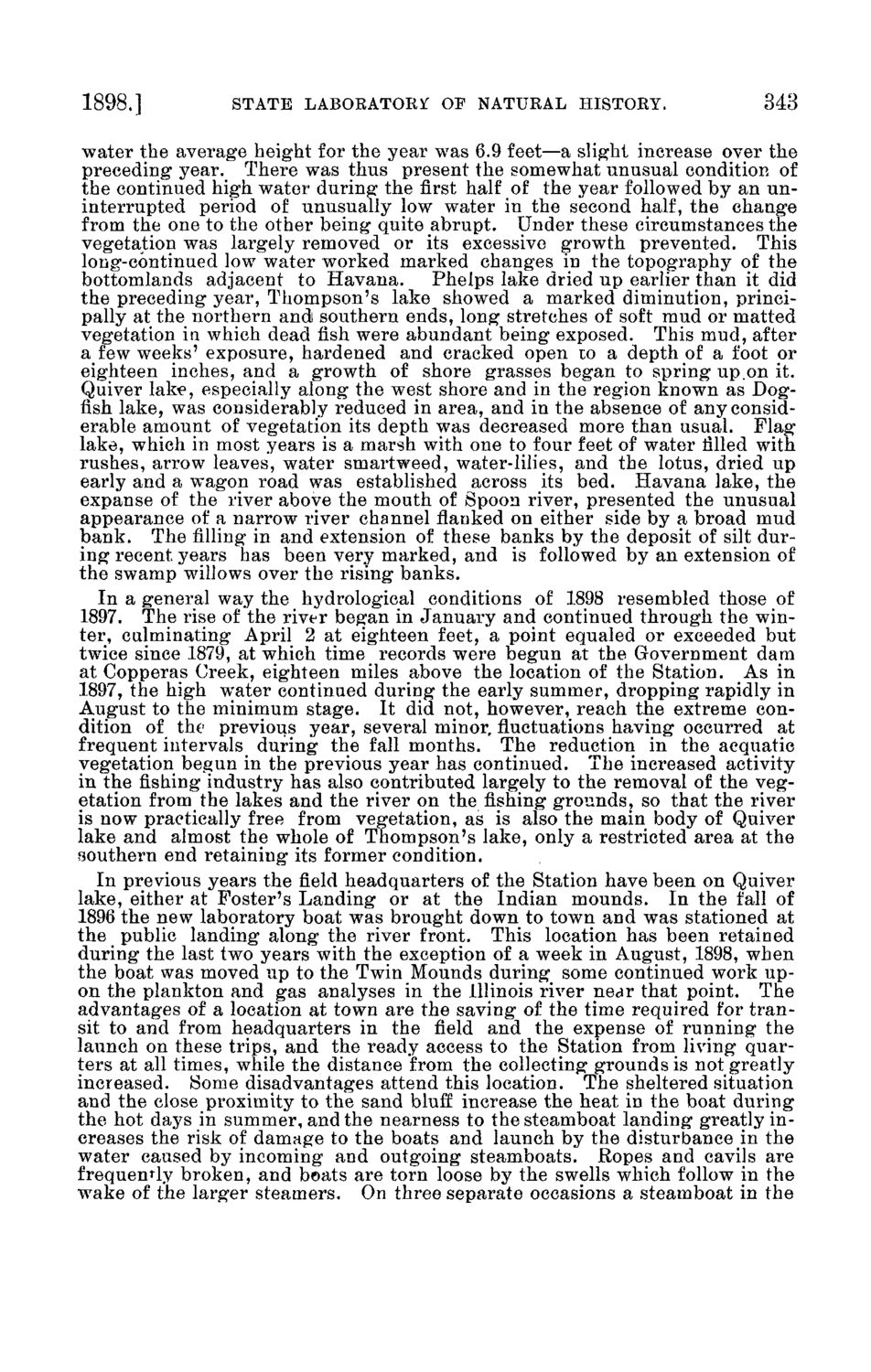| |
| |
Caption: Board of Trustees Minutes - 1898
This is a reduced-resolution page image for fast online browsing.

EXTRACTED TEXT FROM PAGE:
1898.] STATE LABORATORY OP NATURAL HISTORY. 343 water the average height for the year was 6.9 feet—a slight increase over the preceding year. There was thus present the somewhat unusual condition of the continued high water during the first half of the year followed by an uninterrupted period of unusually low water in the second half, the change from the one to the other being quite abrupt. Under these circumstances the vegetation was largely removed or its excessive growth prevented. This long-continued low water worked marked changes in the topography of the bottomlands adjacent to Havana. Phelps lake dried up earlier than it did the preceding year, Thompson's lake showed a marked diminution, principally at the northern and southern ends, long stretches of soft mud or matted vegetation in which dead fish were abundant being exposed. This mud, after a few weeks' exposure, hardened and cracked open to a depth of a foot or eighteen inches, and a growth of shore grasses began to spring up.on it. Quiver lake, especially along the west shore and in the region known as Dogfish lake, was considerably reduced in area, and in the absence of any considerable amount of vegetation its depth was decreased more than usual. Flag lake, which in most years is a marsh with one to four feet of water filled with rushes, arrow leaves, water smartweed, water-lilies, and the lotus, dried up early and a wagon road was established across its bed. Havana lake, the expanse of the river above the mouth of Spoon river, presented the unusual appearance of a narrow river channel flauked on either side by a broad mud bank. The filling in and extension of these banks by the deposit of silt during recent years has been very marked, and is followed by an extension of the swamp willows over the rising banks. In a general way the hydrological conditions of 1898 resembled those of 1897. The rise of the river began in January and continued through the winter, culminating April 2 at eighteen feet, a point equaled or exceeded but twice since 1879, at which time records were begun at the Government dam at Copperas Creek, eighteen miles above the location of the Station. As in 1897, the high wTater continued during the early summer, dropping rapidly in August to the minimum stage. It did not, however, reach the extreme condition of the previous year, several minor, fluctuations having occurred at frequent intervals during the fall months. The reduction in the acquatic vegetation begun in the previous year has continued. The increased activity in the fishing industry has also contributed largely to the removal of the vegetation from the lakes and the river on the fishing grounds, so that the river is now practically free from vegetation, as is also the main body of Quiver lake and almost the whole of Thompson's lake, only a restricted area at the southern end retaining its former condition. In previous years the field headquarters of the Station have been on Quiver lake, either at Foster's Landing or at the Indian mounds. In the fall of 1896 the new laboratory boat was brought down to town and was stationed at the public landing along the river front. This location has been retained during the last two years with the exception of a week in August, 1898, when the boat was moved up to the Twin Mounds during some continued work upon the plankton and gas analyses in the Illinois river near that point. The advantages of a location at town are the saving of the time required for transit to and from headquarters in the field and the expense of running the launch on these trips, and the ready access to the Station from living quarters at all times, while the distance from the collecting grounds is not greatly increased. Some disadvantages attend this location. The sheltered situation and the close proximity to the sand bluff: increase the heat in the boat during the hot days in summer, and the nearness to the steamboat landing greatly increases the risk of damage to the boats and launch by the disturbance in the water caused by incoming and outgoing steamboats. Ropes and cavils are frequently broken, and boats are torn loose by the swells which follow in the wake of the larger steamers. On three separate occasions a steamboat in the
| |